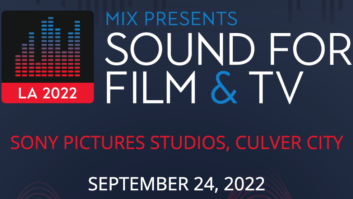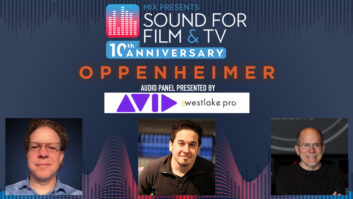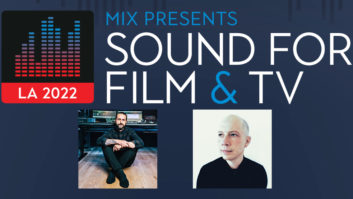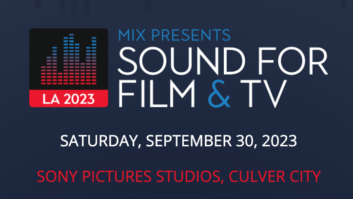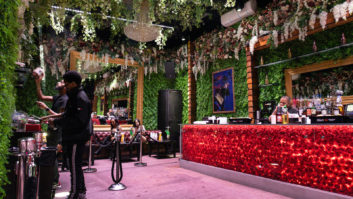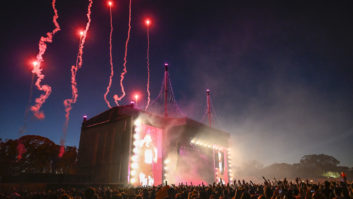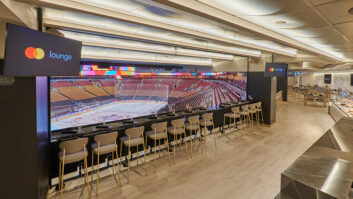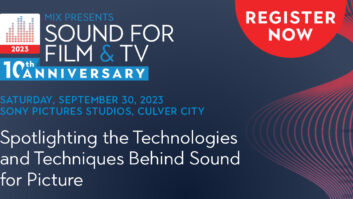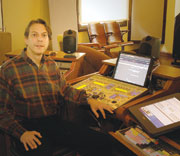
Sound Lounge president Tom Jucarone at the Fairlight DREAM Station in his mix suite, Studio A.
What’s the key to being a successful audio post mix house in New York City? While there are a lot of facilities struggling to discover the answer, Sound Lounge (www.soundlounge.com) clearly figured it out some time ago: Envelop your clients in luxury, creature comforts and a fun atmosphere. While you’re at it, develop great mixers and give them highly advanced rooms in which to work.
“We’ve maintained the same philosophy as when we started six years ago,” says Marshall Grupp, co-partner and sound designer of Sound Lounge. “We wanted to keep this like a family environment — very personable. We thought four rooms was a way to achieve success and support ourselves, but as you become more successful, more people want to come to you and you have to start thinking about expansion. And because we had so many talented people — not just our mixers, but our machine room people and other staff — the growth was really because of demand.”
That might sound like a lot of hype, but the fact is that since the company’s inception in 1998, Sound Lounge has doubled in size to eight mix rooms and increased its staff from 12 employees to 40, while many other New York City audio post houses have been forced to downsize or go out of business. Besides having a good location in the Flatiron district, a huge lounge, in-house chefs and extremely attractive suites for mixing TV/film and radio, Sound Lounge has a firm grasp on its clientele’s workflow, audio needs and expectations — assets that have won it clients like Pepsi, IBM, Nextel, Visa and 7-Up.
“Especially in the commercial business,” says mixer Tom Jucarone, who is also president of Sound Lounge, “it’s [about] being able to deal with people who have different opinions and different insights of the way a commercial should work and then put the music together in ways that meets that. In commercials, you’re not just mixing, you’re an editor, sound designer and mixer and you have to make all those elements work. It’s a burst of energy because you’re not just making music louder or softer. You could be making a new music track and making it all work together. Everything is planned out to tell a story.”
PICKING UP THE PACE
To accomplish these goals, Sound Lounge has to match the industry’s current breakneck pace of technological development if they’re going to keep mixers Jucarone, Peter Holcomb, Rob DiFondi, Rob Sayers, Philip Loeb and Glenn Landrum well-equipped and as future-proofed as possible. The job of overseeing two floors and all eight mix suites (four of which are 5.1-capable), the sound design suite, casting room, stock music room, two machine rooms and two Internet/Intranet file-transfer rooms falls to chief engineer John DeMaio, who has already seen a great deal of change since being hired as Sound Lounge’s first official employee. “I’m not sure where audio post is going technically, but it’s going there fast!” DeMaio states. “If you blink, you’ll miss it. The technology to manipulate audio is amazing compared to five years ago. The systems we had five years ago are long-gone. When we’re done with the next mix room, nothing here will be over two years old.”

Sound lounge co-partner/sound designer Marshall Grupp in Peter Holcomb’s Studio B.
The fast-forward progress of production technology has led to a change in client expectations about the length of their sessions. “What they care about is speed,” maintains Grupp. “Look at our schedule: Sessions are going two or three hours, whereas before, it took a day to do a 30-second commercial.”
“As the technology got faster and faster, so did the sessions,” DeMaio says. “Using tape machines, you had to wait, but now you put the cursor there and you’re editing. The speed of the computers is increasing and the result is the ability to play more and more tracks simultaneously and do more and more edits instantaneously. Now, all of the new systems run on the G5’s 2.2GHz systems, the drives are now running on 60 Mbps and the speed of everything just keeps getting faster to the point that you’re rarely waiting for a computer to do anything anymore, and they don’t crash. So you want to be the fastest, but you also want to be good.”
DeMaio wisely headed off a game of connectivity catch-up when he first wired Sound Lounge. “We were anticipating HD when the facilities were built and we wired for HD video,” he says. “We looked 10 years into the future six years ago so we wouldn’t have to rip out all the wiring that makes it work. Even in a year or two, the infrastructure is more than ready to handle all the HD stuff that’s out there.”
While Sound Lounge hasn’t been overwhelmed with surround jobs, the 5.1 workload is slowly increasing. “Right now, it’s coming from HDTV,” Grupp observes. “As more and more HDTV comes out, the commercials are getting made, so that’s another avenue we’re starting to go down. We’re getting more and more cinema spots, where the commercials are in the theaters.”
The engineering staff has also kept pace with customers’ media delivery preferences, which are strictly electronic. “So many of our clients are not bringing us ‘things’ anymore — we’re getting files over the Internet. Before, everything was tapes, DATs and DA-88s, and the only reason we had Internet access before was so clients could surf the Web. But now, 90 percent of the stuff we use comes over the Internet. We have two networks running simultaneously and are isolated from each other. One is the Internet, where everything comes in and gets scanned for viruses, and then they go to the Intranet. We’re almost tapeless here — the clients prefer it. When things are done here, we start FTP’ing or e-mailing QuickTime movies of our spots. So we’re really using the Internet a lot now, although we haven’t started using it for [uncompressed] video. We’re seeing who comes up with a good way to move video. Those are huge files compared to audio.”
Sound Lounge’s networks also make it convenient for each mixer to share projects and sounds once they’re on the Intranet. “It’s on a server that every editor can see,” DeMaio adds. “[An editor will] grab it and put it back, so we do a lot of file sharing around here, which we didn’t do when we first started.” SoundLounge has two terabyte databases: One is used for backup and archiving, and the other hosts a huge sound effects library with a Soundminer engine and mSoft database. “Every editor can sit while they’re in a session, type in what they want, thousands of choices come up and they can drop it into Pro Tools,” says DeMaio. “Before we went to a networked sound library, one sound effect could take 20 minutes, but now it takes under a minute.”
LOOKING BEYOND POST
Residing on Sound Lounge’s more recently developed downstairs floor is an unusual facility, Sound Lounge Radio. While radio is generally treated like a shameful outcast in media production, Sound Lounge has invested in a full-service center that includes mixing, concept, development, sound design, stock and original music, and voice casting. “I think it’s a natural extension of any audio facility,” says Grupp. “If you only do TV, that’s not good. Radio is a logical choice of expansion for any audio facility. We believe it’s even more challenging because you’re painting pictures with sound. But we feel we brought in a whole team for the agency side — a really strong group of people who could bring the dream alive.”
But even these guys want to get out of the studio once in a while. By adding location recording to their list of services, they’ve done just that for clients such as Coca-Cola and Nike, equipped with a remote Pro Tools|HD system run by a Mac titanium laptop.
“We’re the only ones doing location,” Grupp states, “but it was generated by a creative vision rather than a technical thing. This was about saying, ‘This is a cool idea, why don’t we go out and do it?’ and then finding the clients that say the same thing.”
By extending their creativity beyond simply how they mix and applying it to how they do business, Sound Lounge has emerged with bragging rights as one of the certifiable heavyweights in a town that chooses its champs carefully. “New York City is still the home of the advertising industry,” Grupp says, “and hopefully the majority — and a lot of the great work being done in the country — is taking place here. When we started, there were nine or 10 other places out there. Now there’s two or three. We supply a great service and we have a group of really talented people who are really dedicated and care about their craft. That’s how you get to be big.”
